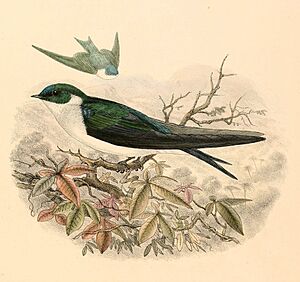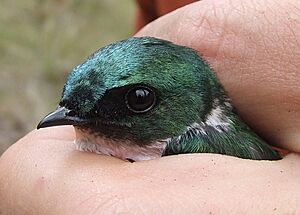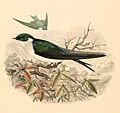Golden swallow facts for kids
Quick facts for kids Golden swallow |
|
|---|---|
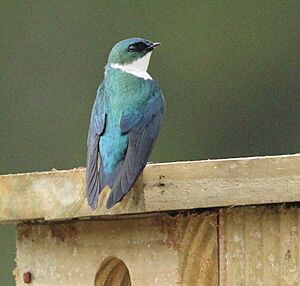 |
|
| Adult in the Dominican Republic | |
| Conservation status | |
| Scientific classification | |
| Genus: |
Tachycineta
|
| Species: |
euchrysea
|
| Subspecies | |
|
|
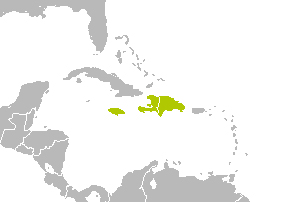 |
|
| Former range in yellow (only extant on Hispaniola) | |
| Synonyms | |
|
Hirundo sclateri Cory, 1884 |
|
The golden swallow (Tachycineta euchrysea) is a beautiful bird that lives only on the Caribbean island of Hispaniola. This island is shared by two countries, the Dominican Republic and Haiti. Long ago, golden swallows also lived on Jamaica, but sadly, they are no longer found there.
These special swallows live in isolated mountain forests. These forests are mostly made up of a tree called the Hispaniolan pine. The golden swallow is considered a vulnerable species by the International Union for Conservation of Nature (IUCN). This means it's at risk of disappearing forever. Scientists aren't sure why they vanished from Jamaica. It might be because of new animals like mammals that hunted them, or because their homes were destroyed.
Contents
What the Golden Swallow Looks Like
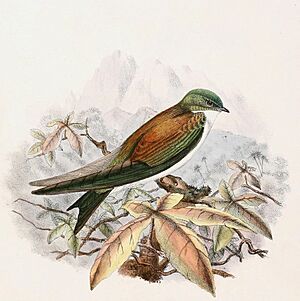
The golden swallow is a small bird, usually about 12 cm (4.7 in) long. The Jamaican type of golden swallow, which is now extinct, had shiny bronze feathers on its upper body and the sides of its head. Its forehead was more green than bronze. Its back, rump, and upper tail feathers were a coppery-bronze color.
Its wings were a mix of coppery, green, and dusky colors. The underside of its body was mostly white. Its legs, feet, and eyes were dark brown, and its beak was black. Female golden swallows looked similar, but sometimes had grey-brown patches on their chest and throat. Young birds were also duller and had more grey-brown patches.
The golden swallows living on Hispaniola today are a bit different. Their tail is more deeply forked, like a V-shape. Their forehead and upper tail feathers are blue-green, and their wings and tail are blue-black. Their underparts are usually pure white without any streaks.
This bird makes a soft, two-note call that sounds like tchee-weet, and they repeat it often.
Where Golden Swallows Live
The golden swallow is native to Hispaniola. The subspecies that lived in Jamaica is now extinct. In Jamaica, they used to live up to 2,000 m (6,600 ft) high, even from sea level. On Hispaniola, they are found from 800 m (2,600 ft) high. When they are not breeding, they might move to lower areas.
These swallows prefer open areas in the hills of the islands. They are sometimes seen in forests or over towns. However, they mostly live in patches of mountain forest where Hispaniolan pine trees grow. They were never very common in Jamaica and were only found in the mountainous, rocky parts of the island.
Life Cycle and Habits
Reproduction
Golden swallows usually build their nests in dead trees, especially Hispaniolan pines. They often use holes made by woodpeckers. They also nest in caves, under the roofs of houses, and in areas where trees have recently burned. Their nests are shaped like a deep cup.
They build their nests with fine plant materials like silk and cotton. They line the nests with cotton, silk, and feathers to make them soft. A typical nest is about 12 cm (4.7 in) wide and 5 cm (2.0 in) deep.
In Jamaica, the breeding season was from June to July. On Hispaniola, it's from April to July. Golden swallows usually nest in pairs, but sometimes they form small groups. They don't seem to fight with other birds for nesting spots.
A female golden swallow usually lays two to four white or creamy white eggs. The eggs are about 18.4 mm × 13.1 mm (0.72 in × 0.52 in) in size. She usually lays one egg per day. The mother bird sits on the eggs for 17 to 20 days until they hatch. The young birds are ready to fly about 24 to 27 days after they hatch.
Diet
Golden swallows are "aerial insectivores." This means they catch and eat insects while flying! They mostly eat flies, Hemiptera (true bugs), and other small insects. They usually fly low to the ground to find food, either alone or in small groups. They rarely fly higher than 20 m (66 ft) when hunting. They are known to hunt in most open areas, but not usually inside thick forests. They typically start hunting at sunrise, are most active in the morning, and slow down in the afternoon.
Predators
Golden swallows face threats from various animals that eat their eggs or young. These include small Indian mongooses, wild cats, and different types of rats. These animals were brought to the islands by humans. Scientists believe these predators played a big role in the extinction of the golden swallow in Jamaica. Nests built close to the ground, like in old mines, are especially at risk.
Conservation Status
The golden swallow is listed as a vulnerable species by the IUCN. This is because there are only a few of them left, their population is getting smaller, and their habitat is shrinking. The Jamaican subspecies is already extinct. The remaining population on Hispaniola is declining mainly due to changes in farming practices and predators like the mongoose and rats.
It's estimated that there are only about 1,500 to 7,000 adult golden swallows left. They live in an area of about 8,100 km2 (3,100 sq mi).
Even though the golden swallow is extinct in Jamaica, it is still legally protected there. It was once common in the 1800s but became rare by the 1890s. The last confirmed sighting in Jamaica was in the Blue Mountains in 1950. The last possible sighting was in 1989.
Scientists like Gary R. Graves from the Smithsonian Institution have searched for the Jamaican golden swallow for many years without success. He believes they are gone because they are active during the day, and Jamaica is a popular place for birdwatchers. He thinks predators like the black rat and the Indian mongoose were the main reason for their disappearance. He also noted that these swallows learned to nest in buildings made by humans, so human activity itself didn't seem to bother them much.
To help the golden swallows on Hispaniola, people are suggesting using nest boxes. These boxes can help protect them from habitat loss and predators.
Images for kids



